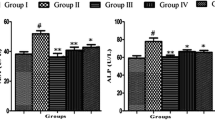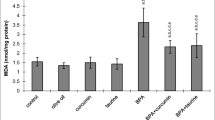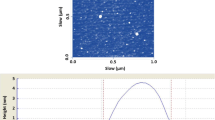Abstract
Curcumin (diferuloylmethane), a biologically active ingredient derived from rhizome of the plant Curcuma longa, has potent anticancer properties as demonstrated in a plethora of human cancer cell lines/animal carcinogenesis model and also acts as a biological response modifier in various disorders. We have reported previously that dietary supplementation of curcumin suppresses renal ornithine decarboxylase (Okazaki et al. Biochim Biophys Acta 1740:357–366, 2005) and enhances activities of antioxidant and phase II metabolizing enzymes in mice (Iqbal et al. Pharmacol Toxicol 92:33–38, 2003) and also inhibits Fe-NTA-induced oxidative injury of lipids and DNA in vitro (Iqbal et al. Teratog Carcinog Mutagen 1:151–160, 2003). This study was designed to examine whether curcumin possess the potential to suppress the oxidative damage caused by kidney-specific carcinogen, Fe-NTA, in animals. In accord with previous report, at 1 h after Fe-NTA treatment (9.0 mg Fe/kg body weight intraperitoneally), a substantial increased formation of 4-hydroxy-2-nonenal (HNE)-modified protein adducts in renal proximal tubules of animals was observed. Likewise, the levels of 8-hydroxy-2′-deoxyguanosine (8-OHdG) and protein reactive carbonyl, an indicator of protein oxidation, were also increased at 1 h after Fe-NTA treatment in the kidneys of animals. The prophylactic feeding of animals with 1.0% curcumin in diet for 4 weeks completely abolished the formation of (i) HNE-modified protein adducts, (ii) 8-OHdG, and (iii) protein reactive carbonyl in the kidneys of Fe-NTA-treated animals. Taken together, our results suggest that curcumin may afford substantial protection against oxidative damage caused by Fe-NTA, and these protective effects may be mediated via its antioxidant properties. These properties of curcumin strongly suggest that it could be used as a cancer chemopreventive agent.


Similar content being viewed by others
References
Hogg N (1998) Free radicals in disease. Semin Reprod Endocrinol 16:241–288
Okada S (1996) Iron induced carcinogenesis: the role of reactive oxygen free radicals. Pathol Int 46:311–332
Athar M, Iqbal M (1998) Ferric nitrilotriacetate promotes N-diethylnitrosoamine-induced renal tumorigenesis in rat: implications for the involvement of oxidative stress. Carcinogenesis 19:1133–1139. doi:10.1093/carcin/19.6.1133
Dutta KK, Zhong Y, Liu YT et al (2007) Association of microRNA-34a overexpression with proliferation is cell type-dependent. Cancer Sci 98:1845–1852. doi:10.1111/j.1349-7006.2007.00619.x
Comporti M (1999) Lipid peroxidation and biogenic aldehydes: from the identification of 4-hydroxynonenal to further achievements in biopathology. Free Radic Res 28:623–635. doi:10.3109/10715769809065818
Esterbauer H, Schaur JS, Zollner H (1991) Chemistry and biochemistry of 4-hydroxynonenal, malonaldehyde and related aldehydes. Free Radic Biol Med 11:81–128. doi:10.1016/0891-5849(91)90192-6
Toyokuni S, Uchida K, Okamoto K et al (1994) Formation of 4-hydroxy-2-nonenal-modified proteins in the renal proximal tubules of rats treated with a renal carcinogen, ferric nitrilotriacetate. Proc Natl Acad Sci USA 91:2616–2620. doi:10.1073/pnas.91.7.2616
Uchida K, Fukuda A, Kawakishi S et al (1995) A renal carcinogen ferric nitrilotriacetate mediates a temporary accumulation of aldehyde-modified proteins within cytosolic compartment of rat kidney. Arch Biochem Biophys 317:405–411. doi:10.1006/abbi.1995.1181
Umemura T, Sai K, Takagi A et al (1990) Formation of 8-hydroxy deoxyguanosine (8-OH-dG) in rat kidney DNA after intraperitoneal administration of ferric nitrilotriacetate (Fe-NTA). Carcinogenesis 11:345–347. doi:10.1093/carcin/11.2.345
Yamaguchi R, Hirano T, Asami S et al (1996) Increase in the 8-hydroxyguanine repair activity in the rat kidney after the administration of a renal carcinogen, ferric nitrilotriacetate. Environ Health Perspect 104:651–653. doi:10.2307/3432839
Toyokuni S, Mori T, Dizdaroglu M (1994) DNA base modifications in renal chromatin of Wistar rats treated with a renal carcinogen, ferric nitrilotriacetate. Int J Cancer 57:123–128. doi:10.1002/ijc.2910570122
Toyokuni S, Mori T, Hiai H et al (1995) Treatment of Wistar rats with a renal carcinogen, ferric nitrilotriacetate, causes DNA-protein cross-linking between thymine and tyrosine in their renal chromatin. Int J Cancer 62:309–313. doi:10.1002/ijc.2910620313
Shibutani S, Takeshita M, Grollman AP (1991) Insertion of specific bases during DNA synthesis past the oxidation-damaged base 8-oxodG. Nature 349:431–434. doi:10.1038/349431a0
Kamiya H, Miura K, Ishikawa H et al (1992) c-Ha-ras containing 8-hydroxyguanine at codon 12 induces point mutations at the modified and adjacent positions. Cancer Res 52:3483–3485
Surh YJ, Chun KS (2007) Cancer chemopreventive effects of curcumin. Adv Exp Med Biol 595:1449–1720
Ferguson LR, Philpott M (2007) Cancer chemoprevention by dietary bioactive components that target the immune response. Curr Cancer Drug Targets 7:459–464. doi:10.2174/156800907781386605
Lin JK (2007) Molecular targets of curcumin. Adv Exp Med Biol 595:227–243. doi:10.1007/978-0-387-46401-5_10
Kuttan G, Kumar KB, Guruvayoorappan C (2007) Antitumor, anti-invasion and antimetastatic effects of curcumin. Adv Exp Med Biol 595:173–184. doi:10.1007/978-0-387-46401-5_6
Johnson JJ, Mukhtar H (2007) Curcumin for chemoprevention of colon cancer. Cancer Lett 255:170–181. doi:10.1016/j.canlet.2007.03.005
Srimal RC, Dhawan BN (1973) Pharmacology of diferuloyl methane (curcumin), a non-steroidal anti-inflammatory agent. J Pharm Pharmacol 25:447–452
Srivastava R (1989) Inhibition of neutrophil response by curcumin. Agents Actions 28:298–303. doi:10.1007/BF01967418
Okazaki Y, Iqbal M, Okada S (2005) Suppressive effects of dietary curcumin on the increased activity of renal ornithine decarboxylase in mice treated with a renal carcinogen, ferric nitrilotriacetate. Biochim Biophys Acta 1740:357–366
Iqbal M, Sharma SD, Okazaki Y et al (2003) Dietary supplementation of curcumin enhances antioxidant and phase II metabolizing enzymes in ddY male mice: possible role in protection against chemical carcinogenesis and toxicity. Phamacol Toxicol 92:33–38. doi:10.1034/j.1600-0773.2003.920106.x
Iqbal M, Okazaki Y, Okada S (2003) In vitro curcumin modulates ferric nitrilotriacetate (Fe-NTA) and hydrogen peroxide (H2O2)-induced peroxidation of microsomal membrane lipids and DNA damage. Teratog Carcinog Mutagen Suppl 23:151–160. doi:10.1002/tcm.10070
Toyokuni S, Miyake N, Hiai H et al (1995) The monoclonal antibody specific for the 4-hydroxy-2-nonenal histidine adduct. FEBS Lett 35:189–191. doi:10.1016/0014-5793(95)00033-6
Toyokuni S, Tanaka T, Hattori Y et al (1997) Quantitative immunohistochemical determination of 8-hydroxy-2′-deoxyguanosine by a monoclonal antibody N45.1: its application to ferric nitrilotriacetate-induced renal carcinogenesis model. Lab Invest 76:365–374
Awai M, Nagasaki M, Yamanoi Y et al (1979) Induction of diabetes in animals by parenteral administration of ferric nitrilotriacetate. A model of experimental hemochromatosis. Am J Pathol 95:663–672
Iqbal M, Sharma SD, Rahman A et al (1999) Evidence that ferric nitrilotriacetate mediates oxidative stress by down-regulating DT-diaphorase activity: implications for carcinogenesis. Cancer Lett 141:151–157. doi:10.1016/S0304-3835(99)00100-7
Iqbal M, Giri U, Giri DK et al (1999) Age-dependent renal accumulation of 4-hydroxy-2-nonenal (HNE)-modified proteins following parenteral administration of ferric nitrilotriacetate commensurate with its differential toxicity: implications for the involvement of HNE-protein adducts in oxidative stress and carcinogenesis. Arch Biochem Biophys 365:101–112. doi:10.1006/abbi.1999.1135
Hsu SM, Raine N, Fanger H (1981) A comparative study of the peroxidase–antiperoxidase method and an avidin–biotin complex method for studying polypeptide hormones with radio immunoassay antibodies. Am J Clin Pathol 75:734–738
Levine RL, Garland D, Oliver CN et al (1990) Determination of carbonyl content in oxidatively modified proteins. Methods Enzymol 186:464–478. doi:10.1016/0076-6879(90)86141-H
Uchida K, Szweda LI, Chae HZ et al (1993) Immunochemical detection of 4-hydroxynonenal protein adducts in oxidized hepatocytes. Proc Natl Acad Sci USA 90:8742–8746. doi:10.1073/pnas.90.18.8742
Stadtman ER (2001) Protein oxidation in aging and age-related diseases. Ann N Y Acad Sci 928:22–38
Levine RL (2002) Carbonyl modified proteins in cellular regulation, aging, and disease. Free Radic Biol Med 32:790–796. doi:10.1016/S0891-5849(02)00765-7
Wattenberg LW (1985) Chemoprevention of cancer. Cancer Res 45:1–8. doi:10.1016/S0065-230X(08)60265-1
Zhang D, Okada S, Yu Y et al (1997) Vitamin E inhibits apoptosis, DNA modification, and cancer incidence induced by iron-mediated peroxidation in Wistar rat kidney. Cancer Res 57:2410–2414
Boone CW, Kelloff GJ, Malone WE (1990) Identification of candidate cancer chemopreventive agents and their evaluation in animal models and human clinical trials: a review. Cancer Res 50:2–9
Wargovich MJ (1997) Experimental evidence for cancer preventive elements in foods. Cancer Lett 114:11–17. doi:10.1016/S0304-3835(97)04616-8
Ames BN, Gold LS, Willett WC (1995) The causes and prevention of cancer. Proc Natl Acad Sci USA 92:5258–5265. doi:10.1073/pnas.92.12.5258
Iqbal M, Giri U, Athar M (1995) Ferric nitrilotriacetate (Fe-NTA) is a potent hepatic tumor promoter and acts through the generation of oxidative stress. Biochem Biophys Res Commun 212:557–563. doi:10.1006/bbrc.1995.2006
Hsu DZ, Wan CH, Hsv HF, Lim YM (2008) The prophylactic protective effect of seasamol against ferric nitrilotriacetate-induced acute renal injury in mice. Food Chem Toxicol 46:2736–2741. doi:10.1093/carcin/20.4.599
Iqbal M, Rezazadeh H, Ansar S et al (1998) alpha-Tocopherol (vitamin-E) ameliorates ferric nitrilotriacetate (Fe-NTA)-dependent renal proliferative response and toxicity: diminution of oxidative stress. Hum Exp Toxicol 17:163–171. doi:10.1191/096032798678908486
Iqbal M, Okazaki Y, Okada S (2007) Probucol modulates iron nitrilotriacetate (Fe-NTA) dependent renal carcinogenesis and hyperproliferative response: diminution of oxidative stress. Mol Cell Biochem 304:61–69. doi:10.1007/s11010-007-9486-6
Osawa T (2007) Nephroprotective and hepatoprotective effects of curcuminoids. Adv Exp Med Biol 58:407–423. doi:10.1007/978-0-387-46401-5_18
Eybl V, Kotyzova D, Cerna P, Koutensky J (2008) Effect of melatonin, curcumin, quercetin and resveratrol on acute ferric nitrilotriacetate induced renal oxidative damage in rats. Hum Exp Toxicol 27:347–353. doi:10.1177/0960327108094508
Kasai H (1997) Analysis of a form of oxidative DNA damage, 8-hydroxy-2′-deoxyguanosine, as a marker of cellular oxidative stress during carcinogenesis. Mutat Res 387:147–163. doi:10.1016/S1383-5742(97)00035-5
Umemura T, Hasegawa R, Sai-Kato K et al (1996) Prevention by 2-mercaptoethane sulfonate and N-acetylcysteine of renal oxidative damage in rats treated with ferric nitrilotriacetate. Jpn J Cancer Res 87:882–886
Hermanns RC, de Zwart LL, Salemink PJ et al (1998) Urinary excretion of biomarkers of oxidative kidney damage induced by ferric nitrilotriacetate. Toxicol Sci 43:241–249
Akiyama T, Hamazaki S, Okada S (1995) Absence of ras mutations and low incidence of p53 mutations in renal cell carcinomas induced by ferric nitrilotriacetate. Jpn J Cancer Res 86:1143–1149
Winter CK, Segall HJ, Haddon WF (1986) Formation of cyclic adducts of deoxyguanosine with the aldehydes trans-4-hydroxy-2-hexenal and trans-4-hydroxy-2-nonenal in vitro. Cancer Res 46:5682–5686
Chung FL, Chen HJC, Guttenplan JB et al (1993) 2,3-Epoxy-4-hydroxynonanal as a potential tumor-initiating agent of lipid peroxidation. Carcinogenesis 14:2073–2077. doi:10.1093/carcin/14.10.2073
Amici A, Levine RL, Tsai L et al (1989) Conversion of amino acid residues in proteins and amino acid homopolymers to carbonyl derivatives by metal-catalyzed oxidation reactions. J Biol Chem 264:3341–3346
Uchida K, Stadtman ER (1992) Modification of histidine residues in proteins by reaction with 4-hydroxynonenal. Proc Natl Acad Sci USA 89:4544–4548. doi:10.1073/pnas.89.10.4544
Szweda LI, Uchida K, Tsai L et al (1993) Inactivation of glucose-6-phosphate dehydrogenase by 4-hydroxy-2-nonenal. Selective modification of an active-site lysine. J Biol Chem 268:3342–3347
Uchida K, Stadtman ER (1993) Covalent attachment of 4-hydroxynonenal to glyceraldehyde-3-phosphate dehydrogenase. A possible involvement of intra and intermolecular cross-linking reaction. J Biol Chem 268:6388–6393
Uchida K, Toyokuni S, Nishikawa K et al (1994) Michael addition-type 4-hydroxy-2-nonenal adducts in modified low-density lipoproteins: markers for atherosclerosis. Biochemistry 33:12487–12494. doi:10.1021/bi00207a016
Acknowledgments
Authors are thankful to Japan Society for the Promotion of Science (JSPS) for providing grant-in-aid for scientific research to support these studies. Authors are also thankful to Dr. S. Toyokuni (Department of Pathology and Biology of Diseases, Graduate School of Medicine, Kyoto University, Japan) for providing monoclonal antibody, HNEJ-2, specific for HNE-modified protein adducts and N45.1, specific for 8-OHdG, respectively. Authors are also thankful to Dr. Nur Asikin (School of Medicine, University Malaysia Sabah) for reading the manuscript and valuable suggestions.
Author information
Authors and Affiliations
Corresponding author
Rights and permissions
About this article
Cite this article
Iqbal, M., Okazaki, Y. & Okada, S. Curcumin attenuates oxidative damage in animals treated with a renal carcinogen, ferric nitrilotriacetate (Fe-NTA): implications for cancer prevention. Mol Cell Biochem 324, 157–164 (2009). https://doi.org/10.1007/s11010-008-9994-z
Received:
Accepted:
Published:
Issue Date:
DOI: https://doi.org/10.1007/s11010-008-9994-z




